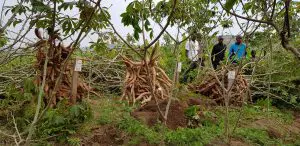16 August 2022
Originally published by IITA, 22 December 2021
IITA and partners—the Rwanda Agriculture and Animal Resources Development Board (RAB), the International Potato Center (CIP), One Acre Fund (OAF), and the Alliance of Bioversity International and CIAT (the Alliance)—are implementing the triadic comparison of technology options (tricot) methodology to help farmers identify the most suitable crop varieties for the local conditions of their farm. This approach has been used since 2020 to identify novel varieties of potato and cassava preferred by farmers for release.
In November 2021, the tricot partners (IITA, RAB, CIP, OAF, and the Alliance) gathered in Rwanda to present and discuss the results from the two years of trials and plan potential next steps for trials and potential mainstreaming of tricot into RAB and OAF. Both RAB and OAF demonstrated interest in a stepped adoption of tricot as part of their variety selection activities.
OAF Agricultural Research Specialist Elyse Tuyishime commented, “We have been using the Randomized Complete Block Design (RCBD) approach in our field trials, which requires all participants to have the same varieties. Alternatively, the tricot approach uses an incomplete block design, allowing participants to use different varieties. Since working on this project, I have realized that this [tricot] approach is very efficient because a researcher does not conduct the trial; farmers lead the research by planting trials under their normal practices and conditions. Moreover, for the RCBD approach, a farmer is passive; therefore, the trials inform primarily a researcher, not a farmer.”
She noted that because farmers actively conduct the trials using the tricot approach, the results inform both the farmer and researcher. Further, the tricot approach is cheaper, as field visits are not necessary, and the approach also facilitates data sharing.”
Tricot trials in Rwanda
Tricot engages farmers as “farmer researchers” in testing or validating new crop varieties and other promising technologies. Each participating farmer executes the mini-task of evaluating only three varieties, out of a range to be tested, in their fields under their actual farm conditions and usual agricultural practices. The methodology does not specify management practices, simply requesting farmers to treat the plots as they usually do their own.
The farmer ranks their preferred variety relative to a suite of traits (e.g., yield, disease resistance, taste, marketability). The methodology works on the premise of external validity to validate varieties.
During the project, RAB, OAF, IITA, CIP, and the Alliance researchers monitored the trials using digital tools. Data collected and recorded through phone-based data collection applications are analyzed in ClimMob (tricot’s analytics application). Farmers from Gicumbi, Nyabihu, and Nyamagabe participated in the potato trials and Bugesera, Kamonyi, Nyanza, and Ruhango, in the cassava trials.

The first season of cassava trials was recently harvested, with farmers and researchers measuring the cassava yield together, thus enabling yield comparisons across varieties and agroecological zones.
“From the yield that I am seeing right now, taking into consideration that these cassava varieties have only been in the ground for 11 months (our local cassava varieties normally mature from 12 to 15 months), these varieties are very promising. I think these varieties will increase cassava production in our area. I have already prepared land to plant these cuttings in the next agricultural season,” said Daniel Habimana, one of the participating farmers from Kigoma sector, Nyanza District, who evaluated the novel cassava varieties using the tricot approach.
The simplicity of tricot allows its use across value chains, not just by producers but also by processors and consumers. More than 100 consumers across Rwanda recently shared their preferences on potato varieties using the tricot approach. Participants were invited to rank their preferred potato varieties, identifying their favorite in terms of taste, appearance, and other characteristics. The initial results from this exercise highlighted that consumers’ preferences were notably different from producers. These results reinforce the need for a full value-chain analysis of varieties before recommending them for release.
The current phase of the project will conclude in Rwanda in December 2021. Despite this, the benefits of the tricot approach are evident by both RAB and OAF showing interest in gradually adopting it for their variety selection research. Following this, the Bill & Melinda Gates Foundation recently approved a pan-African project that will see these activities continue in Rwanda.


